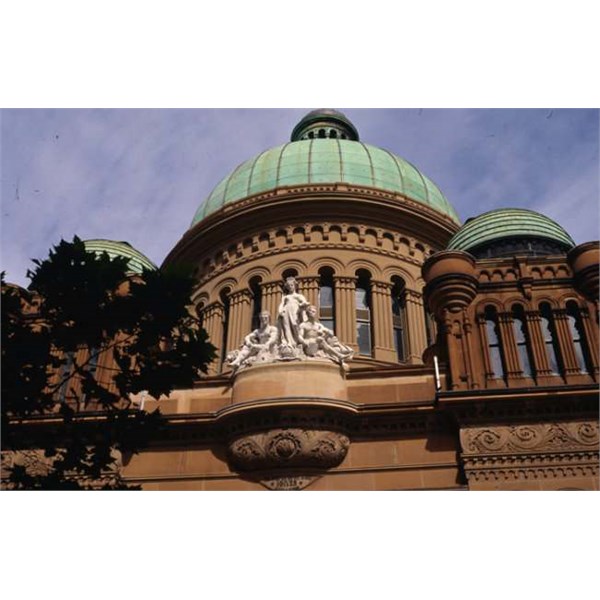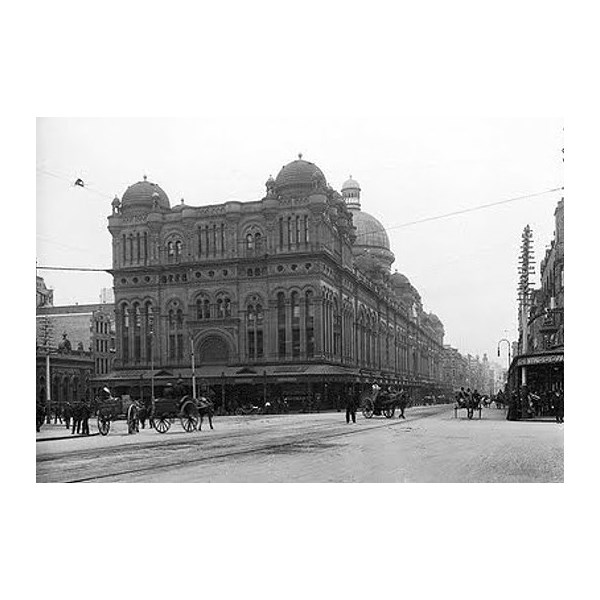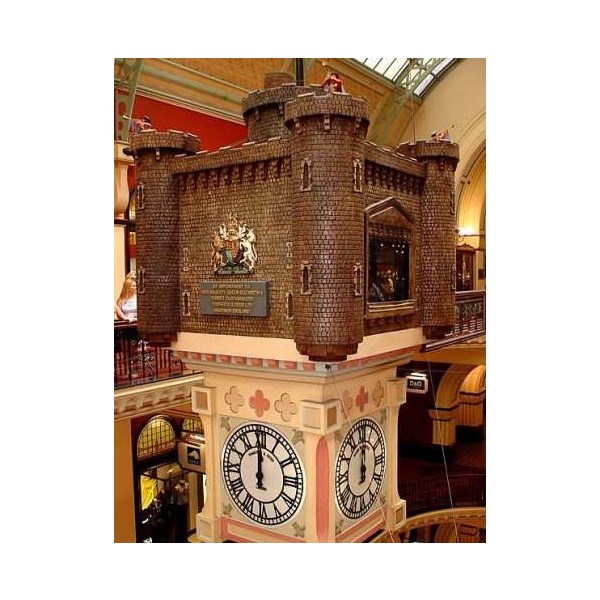Queen Victoria Building is a late nineteenth-century building designed by the architect George McRae in the central business district of
Sydney. The Romanesque Revival building was constructed between 1893 and 1898 and is 30 m (98 ft) wide by 190 m (620 ft) long. The building fills a city block bounded by George, Market,
York and Druitt Streets. Designed as a shopping centre, it was later used for a variety of other purposes until its restoration and return to its original use in the late twentieth century.
The site of the Queen Victoria Building was previously the location for municipal markets, designated by Governor Macquarie in 1810 and was selected for the construction of "a marvellous centre of trade". The completed building included coffee shops, showrooms and a concert hall. It provided a business environment for tradesmen such as tailors, mercers, hairdressers, and florists. Between 1934 and 1938 the areas of the building occupied by the
Sydney County Council were remodelled in an Art Deco style.
The dominant feature of the building is the central dome which consists of an interior glass dome and a copper-sheathed exterior, topped by a domed cupola. Smaller domes of various sizes are on the rooftop, including ones on each upper corner of the rectangular building.

Queen Victoria Building Dome

Queen Victoria Building, 1898
Stained glass windows, including a cartwheel window depicting the arms of the City of
Sydney, allow light into the central area, and the roof itself incorporates arched skylights running lengthways north and south from the central dome. The intricate colonnades, arches, balustrades and cupolas were built in the Victorian style.
The building consists of four main shopping floors. The top three levels have large openings that allow natural light from the ceiling to illuminate the lower floors. Much of the tilework, especially under the central dome, is original, and the remainder is in keeping with the original style. Underground arcades lead south to Town Hall railway station and north to the Myer building.
Two mechanical clocks, each one featuring dioramas and moving figures from moments in history, can be seen from the adjacent railed walkways. The Royal Clock activates on the hour and displays six scenes of English royalty (accompanied by a trumpet voluntary written by Jeremiah Clarke). The Great Australian Clock, designed and made by Chris
Cook, weighs four tonnes and stands ten metres tall. It includes 33 scenes from Australian history, seen from both Aboriginal and European perspectives. An Aboriginal hunter circles the exterior of the clock continuously, representing the never-ending passage of time.

the Royal Clock
The building also contains many memorials and historic displays. Of these, two large glass cases, removed in 2009–10, stood out. The first display case contained an Imperial Chinese Bridal Carriage made entirely of jade and weighing over two tonnes, the only example found outside China. The second was a lifesize figure of Queen Victoria in a replica of her Coronation regalia, and surrounded by replicas of the British Crown Jewels. Her enthroned figure rotated slowly throughout the day, fixing the onlooker with her serene and youthful gaze.
At the southern end of the building is the Bicentennial Plaza, facing the
Sydney Town Hall across Druitt Street. Another statue of Queen Victoria can be found here, arrayed on a light
grey stone plinth, the work of Irish sculptor
John Hughes. This statue stood outside the legislative assembly of the Republic of Ireland – Dáil Éireann in Leinster House, Dublin, – until 1947, when it was put into storage and was given to the people of
Sydney by the Government of the Republic of Ireland in the 1980s. It was placed on its present site in 1987.
The building steadily deteriorated and in 1959 was threatened with demolition. It was restored between 1984 and 1986 by Ipoh Ltd at a cost of $86 million, under the terms of a 99-year lease from the City Council and now contains mostly upmarket boutiques and "brand-name" shops.

Trams on George Street in front of the QVB

Statue of Queen Victoria in front of the Queen Victoria Building
In January 1978, the Hilton Bombing damaged the glass in QVB which led to its replacement in 1979. Fortunately, Ipoh Gardens beautifully restored the building during 1986 and retained its exemplary features including the trachyte stairs, tessellated tiles surfaces, and column capitals. This particular act of preserving the legacy of the past, has paved way to Queen Victoria Building’s survival in the 21st century. Today, the commercial establishment houses high- end fashion stores, cafes, and restaurants which leads us back to the original purpose of the building in the city of
Sydney
Nearby stands a wishing
well featuring a bronze sculpture of Queen Victoria's favourite dog "Islay", which was sculpted by local
Sydney artist Justin Robson. A recorded message voiced by
John Laws urges onlookers to give a donation and make a wish. The tens of thousands of dollars cast into this
well annually benefit deaf and blind children.
.